It’s a question that comes up in gun groups on a regular basis: what’s the best AR-15 scopes under X dollars? And just as regularly comes the stream of replies, most forgetting a minor detail beyond their own bias one way or another: application.
What’s the intended use of said affordably priced optic? How rigorously will it be used and on what gun?
Because of those variables I’d be doing you a disservice if I tried to claim this was an all-encompassing list of the best AR-15 rifle scopes. It isn’t, it’s just a few suggestions of some very good options in a range of prices with various applications like target shooting or for your favorite hunting rifle. With that in mind, here are five AR-15 optics you need to consider the next time you’re looking to buy.
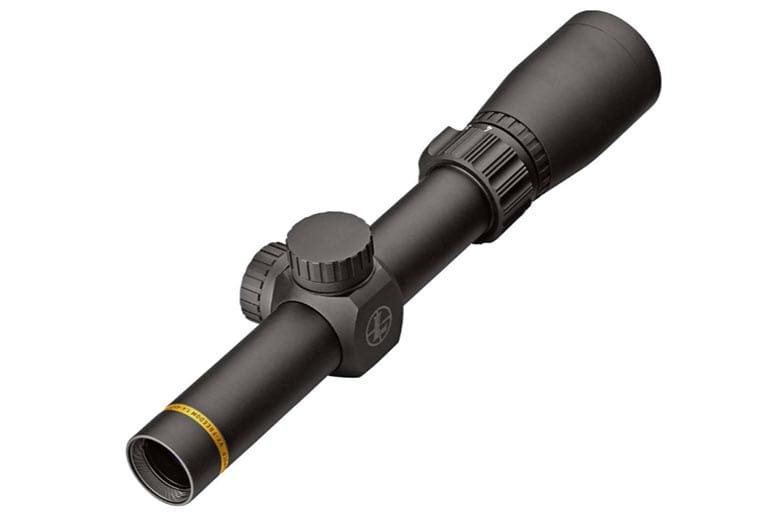
This isn’t just one model it’s an entire line-up of affordably-priced scopes from one of my preferred manufacturers. It includes options for everything from ARs to Scout rifles to muzzleloaders; whatever your firearms preference might be you’re probably covered. Not only are the all the scopes in the VX-Freedom line under $500 cap, they all start under $400 (customization can affect cost).
My experiences with the VX-Freedom line have been positive. The 1.5-4×20, specifically, is a good example of the line’s versatility and quality. Scope features include a 3:1 zoom ratio, one-inch tube, and waterproofing as well as fog-proofing. Click value is ¼ MOA. In addition, the second focal plane scope is made from 6061-T6 aircraft grade aluminum and has scratch-resistant lenses.
It’s a well-made, high quality, durable rifle optic. I wouldn’t purposefully beat it on trees or take it on a rugged mountain hunt but for general purpose use it’s a very solid choice. This is a great scope and a fantastic example of a product performing not only within but beyond its price point.
MSRP for the Leupold V-Freedom 1-4×20 is $259.99.
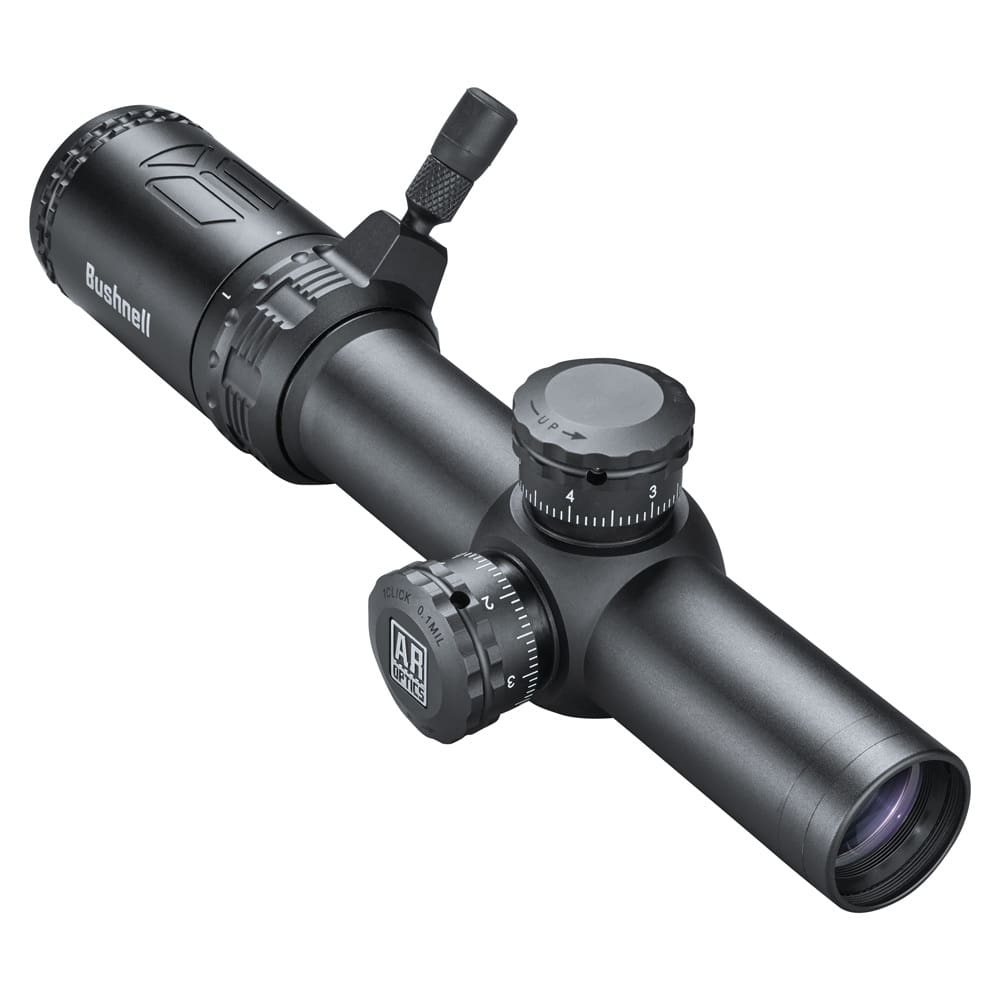
The Bushnell AR Optics 1-4×24 is another affordable close quarters AR-15 scope that gives you a lot for your money. Build quality is above its price point with clean, precise turret click adjustments and smooth zoom operation including a built-in swing-away throw lever for fast adjustment. Its multi-coated glass is crisp and clear for good performance, even in low-light conditions.
The AR Optics 1-4×24 gives you choice of both first and second focal plane models with three different reticle choices, some illuminated. Eye relief is 3.5 inches, and the scope has 120 MOA of elevation adjustment and 140 MOA windage adjustment.
Busnell’s AR Optics scopes range in MSRP from $199 to $399.
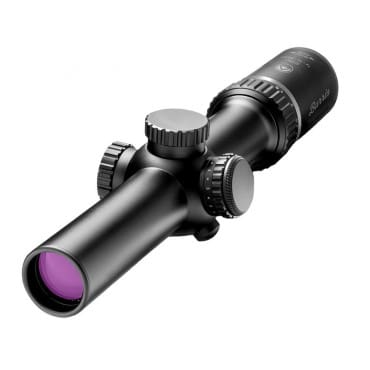
Photo courtesy Burris
Burris MTAC Riflescope 1-4x24mm
This scope from Burris was originally designed for CQB work but it’s also a viable option for hunters. Keep in mind most deer hunters don’t take shots outside 150 yards – if we’re being generous, really it’s more like within 100 yards – which means a short-range model is fine. The Burris MTAC Riflescope 1-4x24mm is available with either a Ballistic CQ or Ballistic AR reticle, various finishes, and as part of different kits.
The matte-black finish MTAC with a Ballistic AR reticle has features such as illumination, 1-4x magnification, and 3.5-to-4.0 inch eye relief. Click value is ½ MOA and its total elevation adjustment capability is 130 MOA; windage adjustment capability is also 130 MOA. It’s parallax free and has a 30mm tube. It’s a nice short-range scope for your close-quarters rifle – hey, if you use an AR for home defense you’d better be doing some CQB training with it. Winging it is not the answer.
MSRP for the Burris MTAC Riflescope 1-4x24mm starts at $479 and it’s worth noting I’ve seen them for $399 online (scope only, matte black).
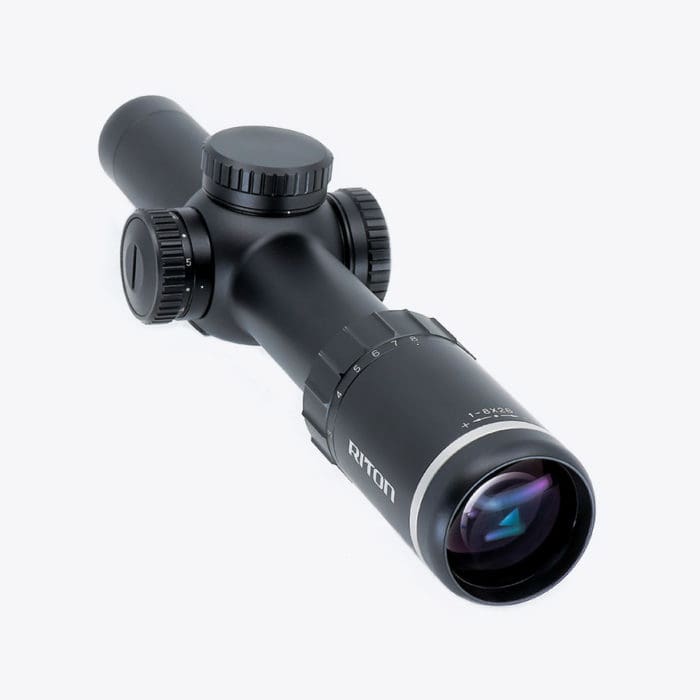
Photo courtesy Riton Optics
Riton RTS MOD 7 1-8×28 IR-T (Tactical)
Riton offers a variety of good-quality scopes for many uses but this particular model is meant for close-quarters use. The Riton RTS MOD 7 1-8×28 IR-T was designed by the company in conjunction with retired Navy SEAL Team Sniper Charlie Melton, a guy I’ve spent time shooting and hunting alongside. Charlie knows his stuff so it’s no surprise this is a solid AR optic.
The RTS MOD 7 1-8×28 IR-T is a first focal plane optic with an illuminated reticle. It is made from 6061-T6 aircraft-grade aluminum and is Type III Hardcoat Anodized. Thanks to its being dry Argon purged and sealed the optic can withstand whatever the weather throws at it, a valuable feature in any optic. Yes, it is 100-percent waterproof, fog-proof, and shock-proof. It’s great in low light and made to take a beating which is precisely what you need from a solid tactical scope.
Other features include capped turrets with zero reset and ½-MOA per-click adjustments, a fast-focus eyepiece, and six daylight-bright settings. The optic is 10.9-inches long and weighs 25 ounces. Eye relief is four inches and all their optics have an unlimited lifetime warranty
I’ve run several Riton optics and have been pleased with their performance every time from tactics to hunting to red dots. They’ve got it all covered and are, in my opinion, an unsung star of the optics world. Riton is a name I’d like to see mentioned with greater frequency.
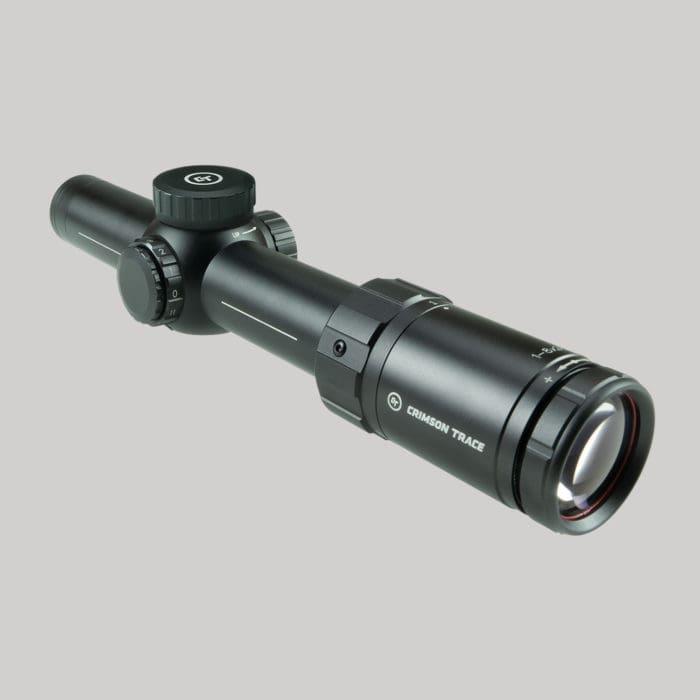
Photo courtesy Crimson Trace
Crimson Trace CTL-5108 5 Series Tactical Riflescope 1-8x28mm
I admit it. When I first found out Crimson Trace was coming out with a riflescope line I was excited. As a long-time user of their products I had high hopes for their new optics and when I finally got my hands on them I was not disappointed. In fact, I was – am – thrilled. This optic is the one specifically designed by the company for tactical work at shorter ranges. Is it good? Uh, yes.
The 5 Series Tactical Riflescope 1-8x28mm is, like most tactical scopes, a first focal plane optic. The reticle is a custom Crimson Trace creation called the SR1-MIL made for rapid target acquisition and accuracy. The reticle is illuminated and, because it is an FFP, is located ahead of the magnification. There are multiple windage holding points and the multi-coated ED glass has exceptional clarity. Turrets offer precise, defined clicks; turret adjustments are .2 milliradian. Elevation and windage range are each 35 MIL. Illumination range is 11x daylight and 3x night.
Overall length of this optic is 10.9-inches and it weighs 22.4 ounces. This is a fantastic optic with a broad field of view of good eye relief. The SR1-MIL reticle really does get you on target quickly and the optic is well on its way to becoming a favorite. Crimson Trace did a wonderful job launching this line and I look forward to seeing what they add to it in the future.

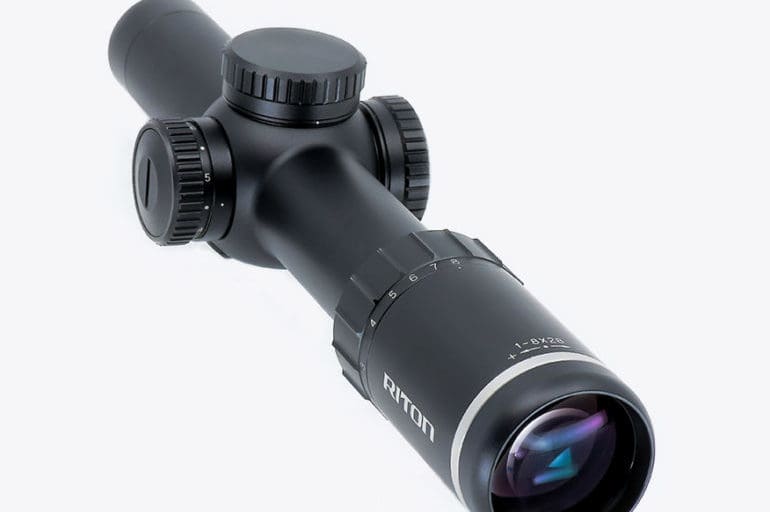
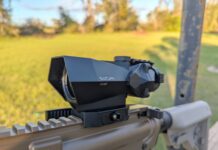


no Primary arms 1-6/1-8 scopes on there? They are very affordable and have great features.
2nd Primary Arms. 1-6 on my Go-To AR.
Very Affordable and good glass.
Noticed that too. I’ll bet they don’t pay as well. Lol
couldnt agree more. I actually gave away my burris MTAC for a Primary Arms 1-6. Why? Reticle reticle reticle. its all about the reticle for me, and anyone who would put MTAC on this list with that ugly, imprecise reticle lost a bit of credibility. hell, this article should just show reticles and not the scopes if only 1 pic was gonna be added.
I agree…I’m very satisfied with my PA 1-6x optic
The PA 1-6×24 is what I run on my 3-gun AR. Glass is pretty good, the ACSS reticle is second-to-none, it holds zero in non-cushy conditions, and it’s less than 300 clams with a good warranty.
Thank you, I was thinking the same thing. Love the PA I have on my AR, everyone who’s tried it likes it to.
Exactly my thoughts.
How is a $1300 Scope the BEST option? if the scope costs more than the gun? skip the riton and crimson trace go to Primary arms and spend $249 and get something similar.
Most of the time, on any Precision Gun, the scope should cost more than the gun. Buy the best optic you can possibly afford, and upgrade the gun under it over time.
What he said. 👍
jwtaylor,
I have heard many people share the same line of thinking. What is the actual explanation?
I ask because the primary components of a scope are coated glass, a metal tube, and turrets. Very high quality glass and anti-reflective coatings are not expensive. High quality metal tubes are cheap. And high quality turrets are cheap. I just don’t understand how a scope that sells for $1,200 can somehow be four times better than an excellent $300 scope. The images will be indistinguishably bright, sharp, and high contrast in both scopes. Both scopes will have long eye-relief. The glass will have the same durability/brittleness. The metal tubes made of the same aircraft-grade aluminum will have the same strength characteristics. The turrets will be equally durable. And both scopes will maintain their point of aim.
The only difference that I can imagine is in the mechanism that adjusts the alignment (e.g. point of aim) of the scope. I suppose it is possible to make one mechanism more robust than another to resist unwanted changes from recoil and bumps. What I cannot imagine is how such a mechanism would account for the $900 price difference. I can see maybe a $50 or $100 price difference. But not $900.
Please enlighten me.
$1 to make the mark in chalk, $49,999 to know where to make the mark.
“The images will be indistinguishably bright, sharp, and high contrast in both scopes”
You had a lot of points in your comment, and I appreciate the detail that you went into. But I have to stop at that one. This is not the case at all. There is a significant difference in image quality, and what you can make out between the scopes at any particular distance.
I have done some side-by-side comparisons between really great glass, and good glass in scope reviews in the past. We can see big differences at even four and five hundred yards. When I say big differences, I mean the difference in being able to tell a buck from a doe, or a legal to shoot deer and an illegal to shoot deer. Those are big differences. If we want to get down to the minute of angle range, there are simply things that you cannot see with a good quality budget scope, like primary arms, and a higher end scope like the better Scopes from Nightforce, US Optics, and others.
That difference is compounded in low light, like twilight. Measuring a primary optics scope against a Vortex razor at five hundred yards, The Vortex scope gave me 20 to 30 minutes more of visible daylight to see through. In both my combat experience, and my hunting experience, those are the most important minutes you get.
There are other considerations, like durability over time, like the precision of movement of the reticle, but those are not nearly as much of a differentiator as quality of the image.
As far as a $5,000 scope being 10 times better then a $500 scope, if the $500 scope will not let me see what I need to see at the distances I need to see it at, it’s not worth $500. It is worthless.
jwtaylor,
Oh, now that is interesting: optic clarity at 400+ yards. I have never even casually looked at targets at 400+ yards, much less having to discern extremely important and minute details at those ranges and beyond in low light.
Out to 200 yards, the images that I see in my Nikon scopes are outstanding and I have no trouble discerning whether a deer is a doe or buck from 30 minutes before sunrise to 30 minutes after sunset, even on cloudy days. It must be a different story at 400 yards and beyond.
I have a fair deal of experience with optics for astronomy applications which are more demanding (visually) than ballistic applications. (Astronomy is even more demanding because we are trying to see minute details on extremely faint objects at enormous distances and magnifications. Or, we are trying to see both exceedingly dim and bright details in the same field of view which requires outstanding contrast.) Once you have baffles (to prevent internal reflections and stray light which degrades contrast) and high quality glass (with multiple coatings on every surface) which is ground accurately for focused images, there is nothing more that you can do to improve optical clarity and quality. These days, that is easy to do and fairly inexpensive. That should translate to rifle scopes as well.
Maybe the high price of premium rifle scopes is in the design itself since they have so many lenses. Telescopes have a simple objective lens/mirror. Once you have quality glass, coatings, and precision grinding, you have maxed optical quality and there is no way to justify a high price tag. But, if you have to design, manufacture, and locate/align 9 lenses rather than 1 or 2 lenses, that would get pricey — which is exactly what we see in telescope eye pieces. Simple eye pieces are available for $20. The best eye pieces cost several hundred dollars because they are so much more complex.
Thanks for the explanation.
Uncommon Sense, I too, often wonder why scopes cost what they do, but, for me, until I figure out how to make my own (and that’s not a priority), that’s the cost to get them to do what I want them to do.
Here’s an example from taken from my house in one of my reviews.
https://www.thetruthaboutguns.com/2017/12/jon-wayne-taylor/gear-review-sightmark-rapid-ar-1-4×20-shr-223-tactical-riflescope/
u_s – I think high quality glass is one of those things with exploding costs and diminishing returns. A $1000 scope is not going to be twice as clear as a $500 scope, it’s going to be 10% more clear and a $2000 scope will be another 10% more clear etc. Also, since you can buy a 1moa rifle for about $300 these days it seems logical to pay extra for the scope rather than the gun.
JWT – For twilight conditions is it better to pay the big bucks or go with a less expensive 3-9×50? Just looking on Midway, you can get one of those from Nikon, Burris, Vortex, Redfield and Leupold all between $200-250. At least if you’re on a budget that would seem to make sense.
“The images will be indistinguishably bright, sharp, and high contrast in both scopes.”
This is where you are very wrong. Vortex optics did a podcast a little while ago about their Razor HD AMG scope, and in that podcast they had an optical engineer who basically explained how cheap scope manufactures optimize transmission to make the scope appear “brighter” even if the usable light transmission is actually quite poor.
Does this matter to someone who shoots 2 or 3 rounds a year to make sure their gun is “on” and then shoots at a deer thats 75yds away… no it doesnt matter. It doesnt even really matter until you start trying to resolve and engage targets out further than 300 or 400yds… or you start trying to dial corrections at those ranges. That $300 scope will get left in the dust very quickly. I had a $1000 Vortex PST Gen1 on my competition rifle for a long time. It was decent, and probably what I would consider the absolute minimum I would want to run for that kind of shooting. It was great for banging steel at known ranges even out to 1000yds, but absolutely terrible at resolving targets like deer or smaller targets at unknown ranges past 400yds.
I hate all the “BuT wHut aBoUt MUH pRimAry ArMs?” questions… the Primary Arms scopes that are actually any good, are all just as expensive as any other decent optic from any well known “house brand”. The same goes for Vortex, Tract, Athlon or any of the other budget scope makers, the ones that are actually any good all cost over $1000. PA’s top of the line Platinum 1-8 FFP AR Optic costs as almost as much as a Nightforce NX8. Is it good? Probably… I’d still buy the Nightforce every single time though.
I will attempt to summarize the difference between a $300 scope and a $1300 scope very succinctly:
precision and tolerances.
To make a good scope, you need very tight tolerances, and the precision to reproduce them over, and over, and over. This costs money. It costs less money than in the past, but it still costs. Pulling off certain features makes that job even harder.
As an end user, how’s it different? I’ll focus on the topic at hand, which is true 1x to 4-5-6-8 type scopes. (or LPVOs as the industry likes to initialize them) Keep in mind, sub $3000, most scopes will be bundling some subset of these features that all cost money. The $300 crowd will be abandoning most of them and focusing on one or two. The $1000 +/- crowd will try to bundle a number of them and make a compelling product. It is also distinctly possible to build a high quality, expensive product that misses the point entirely.
– Almost all cheap ones will be second focal plane, which is cheaper to make than first focal plane scopes. It’s a LOT easier to do holdover and range estimating under varying circumstances with FFP scopes.
– Consistent eye relief across zoom. A good scope with zoom will try to minimize the change in eye relief with zoom. This is a pain in the butt and costs money. Almost all cheap scopes have more of this than the more expensive ones.
-Forgiving/large eye box. This takes money, and it gets much harder to do the greater the magnification range.
-Have a daylight visible illuminated reticle. As certain patents expire, this is becoming more viable.
-Have a red dot style dot in addition to the reticle.
-Having an etched reticle that can’t break/shift without a whole glass element moving. This used to be for more expensive scopes, but is also becoming a more universal feature.
-resettable zero stops. the 1-??? scope market is not about measuring wind and twiddling turrets. It’s about using your reticle and holdover, and usually in competition or real world situations that can bang your optic around. So being able to tell if anything got knocked out of position and being able to put it back is useful.
-clarity of glass and light transmission. Cheap glass is getting better, but good glass is still superior.
-distortion – here I’ll bundle barrel distortion, chromatic aberration, etc. It costs to avoid this and the higher the magnification power, the harder it is suppress chromatic aberration under all lighting conditions.
-TRUE 1x. LOTS of cheap scopes aren’t really nailing true 1x. And how well a scope does it is affected by price, but also the end user’s vision. Good scopes will get much closer and seem that way for a wider audience. With less certainty I’ll state 1x done well seems to reduce parallax issues at 1x. This costs.
-Zoom ratio. the industry started with 1-4, then hit 1-6, 1-8 is becoming more widely available and with a better set of options from this list for the dollar. Right now 1-10 is the holy grail and you see it hitting, but the players known for doing it right are still not launching product because it’s too much of a compromise or too expensive for the extra 2x.
-Weight – good optics, a larger zoom range, and minimal weight COSTS. At least the only ones pulling it off are EXPENSIVE.
-Ergonomics and creature comforts – built in cat tails, illumination controls with every other position being off, etc. They all cost something over the normal simple version. Things like if the reticle is in mils, the adjustments should be mils, and same if the reticle subtentions are MOA.
-Fit and finish of the non critical bits.
-Reticle design. A good reticle needs someone who knows what they are doing to make it, and those people cost money. Or they don’t really, but you have to pay people to wrangle them and get input and feedback while they go about their day job.
As a simple example, I’ll compare the vortex strike eagle 1-6 and vortex razor II 1-6.
The Razor has what is perhaps the most forgiving eye box I have ever encountered. The glass is bright, sharp, chromatic aberration is well controlled for the price point, and there is minimal barrel distortion, mostly creeping in a the 6x end of things. The reticle is well designed and fine where it needs to be to not obstruct targets, and the daylight illumination is basically a red dot bright red dot. It sticks to a 30mm tube making rings easy to find. It is SFP. And it is a bit heavy at ~26 oz. Vortex goes through a LOT of effort to hold sub micron tolerances to make the thing work the way it does.
The strike eagle has glass that is pretty sharp but way less bright. Full noon sun they look similar at 1x. In dim light, the glass comes off as almost hazy. there is more barrel distortion as you hit 6x. The eye box is way less forgiving and the eye relief is less consistent across the zoom range. The reticle is technically daylight visible, meaning in bright light it’ll look flat red with no pop rather than black. Getting the job done with a simpler system means less elements in the optic, and it comes in at only ~17oz. It’s a great value, but you get some significant improvements for your money with the razor.
For example the S&B 1-8×24 PM II ShortDot Dual CC bundles pretty much all of the above, with a FFP horus style reticle WITH a red dot SFP illuminator, in a 24mm tube AND does it all in only 22oz. I’ve been told it does it all well. I haven’t met on in person because it costs $4500!!!!!
IMO currently the cheap scopes that are worth the time are the vortex strike-eagles (1-6 and 1-8).
Best value for features are vortex razor HDII 1-6x ($1100 if you catch a sale), Trijicon accu power 1-8x (occasionally hits $950 on sale), and the bushnell tactical elite 1-8.5 (about $1000, but I have seen as low as $850 on sale).
Then you get to the mounts. Where I honestly believe if people stopped cheaping out, we could all pay a reasonable price for something good. Not cheap but reasonable.
Rather than putting $1000+ optics on each of your rifles, you’d be better off spending money on good binoculars. Say you have 5 rifles with $1k scopes on them for $5k. You would be better served putting $300 scopes on each of those rifles and then buying $1500 binoculars. You would have all the capabilities you need and still have $2k in your pocket.
These scopes are all 8x or less. We’re talking about mounting them on a carbine. If you’re using a carbine for “precision work” yer doin’ it wrong.
No sir. Not at all. Like many people, I have plenty of minute of angle and sub minute of angle carbines. I want my optic to be able to show me that level of detail.
CharlieTuna,
Rather than thinking of inherent accuracy of a carbine, I think in terms of maximum effective range — specifically with respect to terminal ballistics (e.g. the “killing power” of a bullet at a given range).
A carbine chambered in 5.56 x 45mm NATO falls below my personal standards beyond 200 yards. Can a 5.56mm bullet fired from a rifle with a 16-inch barrel kill an animal or human at 600 yards? Sure. Eventually. Will that same platform promptly put down an animal or human at 600 yards? Quite often it will not.
In my estimation a 5.56 x 45mm NATO carbine does not have enough oomph beyond 200 yards. That being the case, I only need a scope that works out to 200 yards, which means a 1-4×20 scope is good enough for combat accuracy out to that maximum range.
“If you’re using a carbine for “precision work” yer doin’ it wrong.”
Ahem… My 16″ LaRue PredatOBR would like to have a word with you.
Because a lot of people are stuck on pre- CNC machining standards for scopes. The standard for ‘the scope should cost twice as much as the rifle’ comes from the 1980s, largely… and a $600 1980s scope is about the same optical quality as a $250-300 scope now.
Riton makes excellent products at reasonable prices. Primary Arms=Holosun when it comes to optics. 100% made in China and imported under the PA name. If you feel the same about Holosun products so be it. Buy what makes you happy! In my experience most optics look and perform OK, until they don’t. The true measure of quality often comes through hindsight after the optic has been through adverse conditions and used with appropriate calibers for your application. Someone shooting a .22 at paper targets could get away with an optic designed for airsoft guns, that doesn’t necessarily make it “good quality”, but it might be fine for the application.
Budget friendly for under $200: TruGlo Tru-Brite 1-6x24mm AR scope, comes with rings and a throw lever. I’ve had mine for a few months, so far, so good. https://www.opticsplanet.com/tru-tg8516tl-tact-ar-sc-1-6x24ir-mt.html
Vortex was my second choice for a little more money.
No Nightforce 1-8 variable? For shame. Sure, it probably costs more than the AR you put it on, but it’s a fantastic optic. Seriously looking at upgrading my SBR to replace the T1 that’s been on there for half a decade.
ATACR
I read this list expecting to see the 1-8x ATACR. Its omission is glaring.
While it doesn’t hold a candle to the Nightforce, the Vortex Razor HD 1-6x is also conspicuously absent from this list, despite being a big favorite in the 3-gun crowd.
Who wrote this list and what on earth were their criteria?
This. No list that ignores Nightforce is a serious list.
If you’re gonna spend more than $500, don’t overlook the CQB scopes by US Optics.
If you are going to spend less than that, the Primary Arms FFP CQB scopes are a very good deal.
This
Here’s a quote from a Defense Review article that says a lot about the quality of the Vortex Viper and Strike Eagle scopes.
“It was just this year (2018) that SOCOM announced Trijicon and Nightforce 1-8x combat optics have been selected. And, even though Vortex Razors have been purchased by a number of Special Operations units, they haven’t yet become a standard SOCOM-issued item. Looking at these rifles, aside from one Night Force optic, the rest are all Vortex Viper PST Riflecopes in 1-6x or Strike Eagle Riflescopes in 1-6x. Now, I know what you’re thinking: ‘Vortex PST and Strike Eagles…but those are the budget models’!
Indeed, they are Vortex’s lower end offerings compared to their Razor line. So, why were they chosen? Well, price was a factor. Speaking with one former teammate, Vortex offered them a good discount. However, that wasn’t the sole reason for choosing them. Vortex’s lower-end scopes have proven to work very well in shooting competitions like 3-Gun.”
http://www.defensereview.com/tactical-ar-15-m4-m4a1-carbine-aftermarket-accessories-for-military-cotactical-ar-15-m4-m4a1-carbine-aftermarket-accessories-for-military-combat-applications-the-competition-to-combat-crossover-part/
I’m a fan of the various 5 or 6 Vortex optics I’ve used over the years, scopes and dots. Definitely worth a look IMO.
Having reviewed many scopes for TTAG in past years (including Bushnell offerings and a Leupold VX-R Patrol), I can’t fault any of the choices presented here.
But I also have to second Mr. Whittle’s nomination of the Primary Arms 1-6x illuminated ffp scope. My AR has worn one for the last three years, with no issues whatsoever. For a hair over $300 including a cantilever mount, it’s a hell of a bargain and a solid piece of kit.
I would tripple your sentiment, but I dont like that mount.
No optics from Primary Arms or Vortex? This is more of an affordable choices list of honorable mentions. If you’re on a tight budget, and spend your hard earned money on a scope. That scope should be a true 1x through whatever unit. With that said, Leupold makes better affordable options as well.
Every rifle I own has 4 power shotgun scope on it. Ive never been able to blow one up. Cant say that about some name branfs Ive owned in the past.
Jay in Florida,
I have heard that scope manufacturers design shotgun scopes to be more robust so that they can handle the recoil of shotguns — which is apparently greater than the recoil that most rifles generate.
Assuming that is true, that is why your shotgun scopes have never failed on rifles.
Speaking of scopes failing on rifles, your comment implies that you have had scopes fail on rifles. How did your scopes fail? Did the optical tube crack? Did the glass lenses crack or shatter? Did they lose their seals and fog-up? Did they become unable to maintain point of aim?
Ive had scopes fog up. Lost their gas. Broken redicles from over adjusting. Mostly though Bushnells fine 3×9 products not being able to hold point of aim on my most used rifle. My ruger 10-22. That rifle has busted more scopes then I care to count. Something about that stinky 22 that loves to chew up scopes. As you pointed out shotgun scopes can take any kind of beating you can think of.
I like the Trijicon accupower 1-4 with the bullet drop reticle. Daylight bright an it’s a true 1 power. It’s not budget tho….
I have it zero at 100 yards. Works great.
I have a Nikon M-223 1-4×20 scope that seems to be pretty spectacular. Not sure why it did not make the list.
Images are bright, crisp, high-contrast, and focused to the edge of the field. It has 4 inches of constant eye-relief and is made of aircraft grade aluminum. And Nikon fills it with nitrogen and seals it so it is supposedly waterproof and fogproof. How is this scope coming up short against the others on the list?
The Vism 1.1x4x24 is a very good scope for the money, illuminated, locking turrets. I have the Burris MTAC an the Leupold Fire Dot an the Vism is 90% of the Burris, just saying.
off topic, but with the huge amount of 3-9 scopes out there why isn’t there much favor towards them?
A true 1x (zero magnification) can be used almost like a red dot for CQB and then dialed up for longer range shots. A 3x is not the best CQB choice.
For cqb roles, who intends to shoot a rifle 15 -150 feet. but using the rifle out to normal range distances out to 300 yards the 1x sighting is not helpful.
“For cqb roles, who intends to shoot a rifle 15 -150 feet”
Every solider and marine everywhere.
I have a 4x on my .22–and getting older, I’ve found that I want to upgrade to 399x because it is hard to make out the 100 yard targets. The AR has a red dot, and I haven’t decided what I think about that. I can’t really call it a precision optic when the dot is bigger than 1 moa. And without magnification, again for those of us with failing vision, those 100 yard targets are hard to see.
Aside from the (glaring) lack of mention of Nghtforce, where is stuff like the Elcan Specter??
The Elcan Specter DR 1-4X is an excellent–albeit unconventional–choice. Good catch.
I would throw the Leupold Mark AR MOD 1 1.5-4x20mm into the mix. Fantastic scope for not a lot of money. Great glass, accurate adjustments and good low light performance
Another TTAG article leaving out SWFA. 🙁
Never heard of them.
Neither had I. Maybe OP was joking; I looked them up and based on the price I’d call them just cheap. If they’re diamonds in the rough I’d love to see an article about them though.
TTAG did a review of one model a few years back, and several rifle reviewers used them on their rifles here at TTAG, too.
Not to mention the US military (Navy Special Warfare, Army) has used the moderately priced ones on .50 BMG, AR family, and M21 rifles.
Tyler did a review of them a few years ago:
https://www.thetruthaboutguns.com/2015/01/tyler-kee/gear-review-swfa-ss-hd-1-6×24/
I have the actual scope and mount that Tyler reviewed (I bought it used from Tyler’s buddy, who was upgrading his competition glass). It now lives on my go-to pig gun (Underground Tactical 6.8 SPC), and it is very nice.
Were I buying a new AR optic today, however, for the same money I’d probably go with US Optics.
Two words: Leupold FIREDOT
How about some scopes for .22lr that don’t cost 10 times more than the gun did? Ya know, varmints smaller than a cat or good plinking? I mean as long as we are talking .22s.
We weren’t talking about .22LRs, though.
Steiner P4xi
Affordable, decent weight, true 1X, daylight bright dot. Boom.
They’re now $800, more than many rifles.
i have a primary arms 1-4x
its been on almost all my ar-15s at one point or another
i like it and everything but i wish i would have waited and bought a 1-6x by either primary arms or vortex
the size and weight aint worth only 1-4x magnification to me
I have Nikon p-223 fixed 3 power scope. It’s short, lightweight, and for the money has awesome glass!
Love My Leupold VX-R Patrol 1.25-4×20 Firedot Scope, MSRP $600, Purchased Mine On EBay.com For $309 – It Has Been a Godsend For My 48yr Old Eyes…
Vortex. Strike. Eagle.
See more about 5 of the Best AR-10 Scope Options
https://scopeslife.com/best-scope-for-ar-10/
Comments are closed.